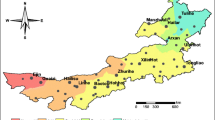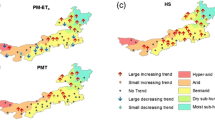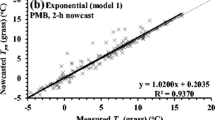Abstract
In an arid environment, the effect of evaporation on energy balance can affect air temperature recordings and greatly impact on degree-day calculations. This is an important consideration when choosing a site or climate data for phenological models. To our knowledge, there is no literature showing the effect of the underlying surface and its fetch around a weather station on degree-day accumulations. In this paper, we present data to show that this is a serious consideration, and it can lead to dubious models. Microscale measurements of temperature and energy balance are presented to explain why the differences occur. For example, the effect of fetch of irrigated grass and wetting of bare soil around a weather station on diurnal temperature are reported. A 43-day experiment showed that temperature measured on the upwind edge of an irrigated grass area averaged 4% higher than temperatures recorded 200 m inside the grass field. When the single-triangle method was used with a 10°C threshold and starting on May 19, the station on the upwind edge recorded 900 degree-days on June 28, whereas the interior station recorded 900 degree-days on July 1. Clearly, a difference in fetch can lead to big errors for large degree-day accumulations. Immediately after wetting, the temperature over a wet soil surface was similar to that measured over grass. However, the temperature over the soil increased more than that over the grass as the soil surface dried. Therefore, the observed difference between temperatures measured over bare soil and those over grass increases with longer periods between wettings. In most arid locations, measuring temperature over irrigated grass gives a lower mean annual temperature, resulting in lower annual cumulative degree-day values. This was verified by comparing measurements over grass with those over bare soil at several weather stations in a range of climates. To eliminate the effect of rainfall frequency, using temperature data collected only over irrigated grass, is recommended for long-term assessment of climate change effects on degree-day accumulation. In high evaporative conditions, a fetch of at least 100 m of grass is recommended. Our results clearly indicate that weather stations sited over bare soil have consistently higher degree-day accumulations. Therefore, especially in arid environments, phenology models based on temperature collected over bare soil are not transferable to those based on temperature recorded over irrigated grass. At a minimum, all degree-day-based phenology models reported in the literature should clearly describe the weather station site.
Similar content being viewed by others
Author information
Authors and Affiliations
Additional information
Received: 25 October 2000 / Revised: 10 July 2001 / Accepted: 10 July 2001
Rights and permissions
About this article
Cite this article
Snyder, R., Spano, D., Duce, P. et al. Temperature data for phenological models. Int J Biometeorol 45, 178–183 (2001). https://doi.org/10.1007/s004840100103
Issue Date:
DOI: https://doi.org/10.1007/s004840100103




